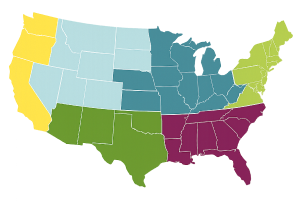
How do we use your location?
Knowing your location helps us recommend plants that will thrive in your climate, based on your Growing Zone.
Russell Lupines are the award-winning hybrids from the labors of a British horticulturist, George Russell. He worked with breeding Lupinus polyphyllus for over two decades. When he displayed his spectacularly colorful results in 1937, all kinds of acclaim and awards were showered on them. He had modified the usually-blue wildflower into a multicolored group of solid color and bi-color blooms. Ever since, the Russell hybrid Lupines have been the basic group from which many new hybrids are created.
The native species, Lupinus polyphyllus, also called Bigleaf Lupine, is native to western North America, from British Columbia and Alberta, south to California and east to Montana, Idaho, and Nevada. They can be found along streams and creeks, in meadows, forests openings, and coastal areas. They prefer cooler climates and moist soil but will tolerate full sun and occasional dry soil. They are deep rooted and can be used for erosion control.
Lupinus polyphyllus and Russel hybrid Lupines may be problematic in Eastern North America; if not properly managed, they may grow aggressively in some regions or habitats, displace desirable vegetation, and hybridize with the Eastern-and-Midwestern-US native L. perennis. Please consult with your local NRCS Field Office, Cooperative Extension Service office, state natural resource, or state agriculture department regarding its status and use.
Why We Love Lupines
As soon as your order is placed you will receive a confirmation email. You will receive a second email the day your order ships telling you how it has been sent. Depending upon your order date, we may hold your shipment to combine it with other products on your order, if applicable. See our shipping information page for approximate ship dates and more detailed information. If you have any questions, please call Customer Service toll-free at (802) 227-7200 or contact us by email or chat.